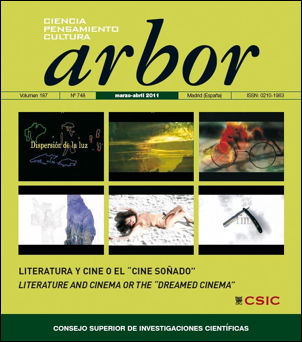3-D audience: the future of the film world?
DOI:
https://doi.org/10.3989/arbor.2011.748n2021Keywords:
cinema, 3D, RealD, spectators, interface, immersionAbstract
This paper analyses the reintroduction of 3D to the big screen, this time, due to the digital technology and the polarization of the image, the focal depth has become more credible and the interface, in spite of still being present, is more comfortable and effective. The spectacular images attract the spectator to the cinema and captivate them with technological visual development. Simultaneously, 3D is a useful tool to solve contemporary cinema problems with piracy and competition with other media. However, the big question that 3D has to solve is whether the new technology will join the large list of fiascos of the 70’s and 80’s, trying to transform the way of seeing the image, or if it will be a step closer to virtual reality and a cinema of immersion and total interaction.
Downloads
References
Aaron, Michele (2007): Spectatorship: The Power of Looking, Londres, Wallflower.
Barthes, Roland (1964): Retórica de la Imagen, Buenos Aires, Tiempo Contemporáneo. Baudrillard, Jean (2001): Selected Writings, Standford, Standford University Press.
Butler, Christian Charles (2009): “For the Love of Film”, Film: Falmouth. http://krisbutler.co.uk/downloads/For%20the%20Love%20of%20Film.pdf.
Casetti, Francesco (1989): El Film y su Espectador, Madrid, Cátedra.
Darley, Andrew (2002): Cultura Visual Digital, Barcelona, Paidós.
Debord, Guy (2000): La Sociedad del Espectáculo, Madrid, Pre-textos. Díaz Gandasegui, Vicente (2008): (Un) real (un)realities: Exploring the confusion of reality and unreality through cinema. Ph.D. thesis., Cardiff, University of Glamorgan.
La Ferla, Jorge (2009): Cine (y) digital, Buenos Aires, Manantial Texturas. Fernández Sánchez, Manuel Carlos (2000): “Imágenes en tres dimensiones”, Revista Latina de Comunicación Social, 31. http://www.ull.es/publicaciones/latina/aa2000kjl/z31jl/87sanchez.htm.
García Canclini, Nestor (2007): Lectores, Espectadores e Internautas, Barcelona, Gedisa.
Gunning, Tom (2004): “An Aesthetic of Astonishment: Early Film and the (In) credulous Spectator”, en Braudy, Leo, Film Theory and Criticism: Introductory Readings, New York, Oxford University Press, 862-877.
Hayes, R. M. (1989): 3D Movies: A History and Filmography of Stereoscopic Cinema, North Carolina: McFarland.
Katzenberg, Jeffrey (2009): “Monstruos Contra Alienigenas”, Fotogramas y Video, Mayo, 112-114.
De Kerckhove, Derrick (2010): “Avatar = Pinocho 2.0 ó El fin de la Sociedad del Espectáculo”, Digithum, 12. http://redalyc.uaemex.mx/redalyc/pdf/550/55013136003.pdf.
Machado, Arlindo (2009): El Sujeto en la Pantalla, Barcelona, Gedisa.
Manovic, Lev (2001): The Language of New Media, London, MIT Press.
Marsh, Tim y Wright, Peter (2000): “Maintaining the Illusion of Interacting Within a 3D Virtual Space”, Presence 2000: 3rd International Workshop on Presence. http://citeseerx.ist.psu.edu/viewdoc/download?doi=10.1.1.28.7072&rep=rep1&type=pdf.
McLuhan, Marshall (1964): Understanding Media: the Extensions of Man, London, Routledge & Keagan Paul.
Münsterberg, Hugo (2004): The Film: A Psychological Study, New York, Dover.
Obando Arroyave, Carlos (2005): “El video: la emición del signo o (per)versiones de la imagen”, Artes, La Revista, n.º 9, Vol. 5, 46-60.
Paz Gago, José María (2004): “El Cine ha Muerto. ¡Viva la Realidad Virtual!”, Arte y nuevas tecnologías: X Congreso de la Asociación Española de Semiótica, 110-125. http://dialnet.unirioja.es/servlet/articulo?codigo=940125.
Peirón, Francesc (2010): “La perspectiva de que se generalice el cine en 3D abre una pugna entre los fabricantes de lentes por el mercado”, La Vanguardia, 10 de enero.
Pereira Domínguez, Carmen; Solé Blanch, Jordi y Valero Iglesias, Luis Fernando (2010): “Avatar un nuevo paso en el séptimo arte. Algunas consideraciones pedagógico-sociales”, Mi ratón. http://www.utp.edu.co/educacion/raton/antes/miraton10/textos/avatar.pdf.
Cowan, Matt (2007): “3D in the Modern Era”, SMPTE Australia. http://www.reald.com/Content/Media-Presentations.aspx.
Valero Ruiz, Carlos y González Gil, José Alfredo (2000): “Bastidor para filmación 3D estereoscópica”, Egráfica. unizar.es. http://www.egrafica.unizar.es/ingegraf/pdf/Comunicacion17052.pdf.
Vera, Pascual (2008): Único Testigo: El espectador ante el fenómeno cinematográfico, Murcia, edit.um.
Zone, Ray (2007): Stereoscopic Cinema and the Origins of 3D film: 1838-1952, Kentucky, The University Press of Kentucky.
Downloads
Published
How to Cite
Issue
Section
License
Copyright (c) 2011 Consejo Superior de Investigaciones Científicas (CSIC)

This work is licensed under a Creative Commons Attribution 4.0 International License.
© CSIC. Manuscripts published in both the printed and online versions of this Journal are the property of Consejo Superior de Investigaciones Científicas, and quoting this source is a requirement for any partial or full reproduction.
All contents of this electronic edition, except where otherwise noted, are distributed under a “Creative Commons Attribution 4.0 International” (CC BY 4.0) License. You may read the basic information and the legal text of the license. The indication of the CC BY 4.0 License must be expressly stated in this way when necessary.
Self-archiving in repositories, personal webpages or similar, of any version other than the published by the Editor, is not allowed.














